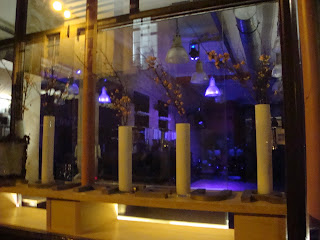 |
| Taysir Batniji, GH0809, 2010. Detail |
Taysir Batniji is a name worth remembering. He has exhibited often enough in the wide range of media in which he works —photography, drawing, installation, sculpture — but the exhibition at Eric Dupont gallery in the Marais was my introduction to his work, and a delight to encounter.
As my friend Dore so rightly pointed out, so much of the work done in and about Gaza, the occupation and Palestinian settlements is repetitive and one dimensional. With a lot of focus on the destruction caused by Israeli military, the film and photographic work done about the conflict asks its viewer to empathize, pity, mourn, and bewail the neverending violence and injustice. And I would add, so much of the work propagates the same message: why can’t we all just get along as people and leave the politics behind?

Taysir Batniji does something altogether different and infinitely more complicated than most of the work on the occupied territories that we usually see. He makes us laugh, provokes our desire, he seduces us into the world of his photographs in inconceiveable ways. And even worse, we are horrified, at the same time as we are mesmerized and our viewing practices mocked. All of this is achieved through photographs, drawings, sculptures and installations that are all at once, documentary, conceptual, experimental and pop culture. The layers of complexity, the high and low culture references, and our seemingly infinite array of responses to this work are what make him someone to watch.
 |
| View of GH0809 section of the Exhibition |
The exhibition at Eric Dupont is in two parts, the first, GH0809 (Gaza Houses 2008-2009) sees a series of photographs replicating the form, language and presentation of real estate announcements. Just like the announcements in storefront windows in Gaza, the properties are presented with a view from the outside, some text waxing lyrical on the features of the goods on sale, and an accompanying set of images representing the bathroom, kitchen, bedroom and living room respectively. Each “advertisement” is fixed behind perspex, each image is rimmed by a red border that includes a reference number. Despite the fact that the descriptions could be mistaken for an ordinary real estate announcement, in most (but not all) cases, the house has been destroyed. To varying degrees, the featured space can range from a pile of rubble to an intact living room that, without the scars left by a missile, might be a place we would want to inhabit.
As I walked through, I shifted from art viewer to apartment hunter. It’s difficult not to be seduced as the language used by Batniji is already familiar to anyone who has ever looked to buy or rent an apartment. I found myself thinking “wow, great space” and marvelling the light, the double exposition, the beautiful blue sky seen through the rubble. The photographs triggered my desire, my habits of consumption, my willingness to dive headlong into the trap of consumerism. Like the photographs we see in the window of every real estate shop, the spaces of GH0809 have been emptied of personalized touches, leaving the generic carpets, window fittings, and so on. They are empty of everyone else, welcoming us as the potential buyer. Similarly, the text plays on the language of real estate advertisements. I find myself echoing it: “look, this one is near the beach,” “oh and this one is close to the local school”, while this one has great potential for extensions. And so I slide into the fantasy of my dream home – just as real estate announcements want me to do.
 |
| Taysir Batiji, Socle du Monde, 2011, Stones |
While Batniji ironically manipulates the real estate announcement is if it were a genre of images, presenting houses as attractive and desirous, I found myself not only starting to imagine life in some of the spaces, but in awe of the aesthetic composition of the images. The perfect blue skies, the sun beaming in, walls that tell the story of the layers of history that have past inside of them, the imitation of the principles of landscape photography all inside perfectly balanced frames, make the images seductive in a different way. Until, I catch myself: I am not just looking at, but I am admiring the aesthetics of bombed out buildings, the debris of missiles that have no doubt killed all on their path. This self-conscious realism, in turn, gives the images an ironic distance that underlies our ability to recognize and reflect on the horror of what has happened in these spaces.
 |
| Exhibition View at Galerie Eric Dupont |
Batniji didn’t take the photographs himself, but rather, had a journalist take them. Batniji was not able to cross the blockade, and so he gave the journalist Sami al-Ajrami the exact specifications of the photographs he wanted him to take. The journalist takes the same photographs from the same perspectives, just different houses. The result reminded me of Bernd and Hilla Becher’s photographs of the industrial heartland of the Ruhr valley. This reference to the Becher’s gives Batniji’s work a claim to a reality that it, nevertheless, announces it does not access through the very same reference. That is, it takes on the contradictions of the Becher’s photographs and sees them through the eye of a twenty-first century conceptuality and aesthetic. This is just one of example of the many layers woven together in Batniji’s complex photographs: they are at once conceptual art, documentary photography, mnemonic archives, avant-garde re-presentations, all of which are undergirdered by the ironic (and very seductive) real estate announcement.
All images copyright the artist.




























